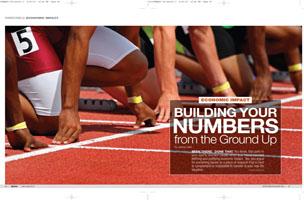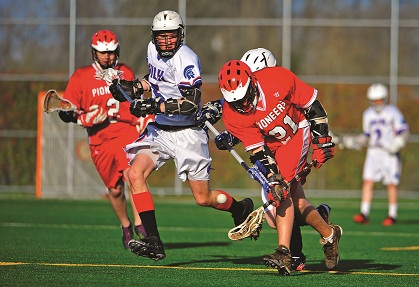
 Been there. Done that. You know, that point in your sports tourism career when you found yourself defining and justifying economic impact. Yes, you argue for something based on a piece of research that is hard to comprehend or impossible to transfer to your real-life situation.
Been there. Done that. You know, that point in your sports tourism career when you found yourself defining and justifying economic impact. Yes, you argue for something based on a piece of research that is hard to comprehend or impossible to transfer to your real-life situation.
I remember the day I googled “economic impact of sporting events." If you haven’t done this, you should. But be prepared for words like exaggerated, inflated, non-supported, and un-scientific. What’s so un-scientific about attracting visitors to your area and making it easy for them to spend money to help boost your local economy? It just seemed SO simple. Or was it?
I’m relatively new to the sports tourism business. I had worked in event marketing and travel, but had never exclusively promoted a destination to the traveling sports market. So I had quite a bit to learn in 2009 when I took on the role of sports and sales director for the Elizabethtown Sports Park. Our sports park hadn't been built yet, but evaluating economic impact was essential from the start.
Why a sports park? And how to evaluate the need?
We already knew our area had a lot to offer to sports fans in terms of an interest perspective. But we wanted to add to that, and to create a sports tourism lure. To do this, tourism officials partnered with local government to build a new tournament-quality outdoor sports complex capable of hosting regional and national events.
 |
| Peter Kim/Dreamstime.com |
What we needed to justify the presence of the park were concrete figures pertaining to the advantages a sports park could offer. How could it make business grow? How would it create a universal benefit for the community, the businesses and the hospitality in the area?
The concept of promoting a sports park was akin to any new business venture: invest in a new business, market it to your target audience, provide good product and services, and reap the rewards. The rewards would be to see our tourism numbers increase, create additional hotel and restaurant tax revenue, support our local retail and entertainment industries, and generate jobs. At the same time, our local kids would get a much-needed new sports facility. And our residents would gain a new city park with a walking trail and picnic areas.
Long time in the making
This journey actually started nearly 10 years ago, when a city planner noted our local ballparks needed a facelift. The money never seemed to be there or was always cut in the final stages of annual budget prep. It took smart and dedicated people to evaluate our need, identify a niche, research possible solutions, learn new state laws, lobby and promote the use of tourism dollars to create a sports destination. Without this ingenuity and drive to encourage lawmakers to back this idea, this park would probably still be just that, an idea.
With a newly appointed mayoral committee, tourism tax dollars were committed, and an old sports facility expansion master plan was dusted off. A design firm was identified through an RFP. We were ready for kick off. This complex needed to be special. It had to be THE reason for people to come. It was expected to bring dollars to our community. But the big question had to be answered: What kind of impact – in dollars and people – would it truly bring?
When it came to promoting the potential impact of the new Elizabethtown Sports Park, I went straight to my industry friends and resources. I found an economic impact template (NASC has a good one), and gathered relevant research from Kentucky’s state tourism office. I spent months during our design phase with a spreadsheet and my telephone.
We computed factors like average number of players, teams, and sizes of events, and we spent hours on research about tourism spending trends, sports vacations, the youth sports market, etc. Using as many hard numbers as I could, we created a formula. The goal was to be able to stand behind every qualifier and to defend these economic impact projections.
 |
| James Boardman/Dreamstime.com |
Part of our research included getting to know people and places in the industry. Where were the best parks? Who built them, promoted them? Would it be possible to request an actual appointment with these people at a trade show? Our industry is full of awesome people making a huge difference every day. Many sports tourism programs are grassroots efforts where hard-working, smart go-getters have figured it out.
The mathematical work of economic impact is incredibly detailed. We crunched the numbers, added them by sport, then per season, then estimated hotel room nights, figured in restaurant opportunities and finally, a landscape started to emerge. After making adjustments for hotel capacities, we began to come up with predictions about which we felt very conservative. Still, doubts lingered:
• What if the lodging tax doesn’t reflect any growth in year one?
• What if our local restaurant tax only shows a minimal increase?
• What if hotel managers tell other business owners that they haven’t seen an increase in business since the sports park opened? Then what?
Economic impact planning can be complex and even scary for those who are doing it for the first time, or for those who are evaluating a new project.
Here is how we broke it down…
Given our location in the country, central Kentucky has all four seasons, some wetter and colder than we’d like. But still, after consulting those in the know, our team felt we could potentially get an average of close to nine full months of operation each year. Next, our design would allow us, at full capacity, to run events for multiple sports at the same time. Once our service model was in place, we could host baseball events on the same weekend as lacrosse.
Now, there were limitations to consider. Etown, as we call our area, is a community of only 28,000 people in a county of just over 100,000. We currently have 1,500 hotel rooms and just over 100 restaurants. Our city is a growing, thriving region, but it would be years before our real estate growth would catch up with our park, which was part of our long-term strategic plan. The park could serve as the singular reason for the development of new hotels, restaurants, and entertainment ventures.
 |
| James Boardman/Dreamstime.com |
Then there were operational type things to consider. Things such as rotating events to preserve the pristine sports turf and not over-playing fields until they are well established. Also of concern is athlete safety and wanting to deliver facilities that would boost player confidence and performances.
Our organization considered the reality of having all new staff members not familiar with the workings of hosting large sports events. The operations staff and concession associates would need some time to understand the demanding schedule and level of service needed to promote the park and our city to visitors. While we had recruited top-notch turf specialists, those hardworking crews responsible for lining fields, mowing, applying chemicals, beautification, etc. would all need some time to sharpen their skills. All things considered, even once we opened the park, there would still be some on-the-job training.
The park opens in July of this year. To date, we’ve successfully contracted for 28 events. These events are mostly statewide and regional in nature, some a little smaller, some a little larger. In working with each client, our goal is to manage the estimated number of teams, athletes, visitors, and overnights.
For the CVB’s projections, we’ve tried to isolate the non-locals, those that count as “tourists” in order to determine visitor spending and true tourism impact. We’re looking forward to welcoming over 10,000 visiting athletes to the park within the first five months of operation. We’re estimating over 25,000 visitors total during these first 28 events. Given our average spending figures, these events could represent close to $6.2 million in direct visitor spending. This does not include any local or non-overnight visitors. It does not include local league games or community events. Only visitors. That is the focus of our projections from the tourism side of the world.
Now, the operations staff must use other numbers for planning purposes. Total visitors, plus local spectators, league games, community events that will be held at the park such as concerts or car shows. Staffing for concession, ticketing, field crews, maintenance, cleaning, etc. is a whole different ball game. Thankfully, there are seasoned professionals in place for that, too. It’s a tough job and the pressure is definitely on for them, but they are very prepared and making solid plans.
 |
| Susan Legget/Dreamstime.com |
Like many of my sports tourism friends, I’ve always believed in the “under-promise and over-deliver” method when it comes to event planning, so I’m looking forward to over-delivering on our estimations. Fast-forward five to ten years down the road and it would be nice to see our park consistently generate close to $35 million in impact annually. And, I feel it can happen once we really find our feet and are able to grow in all areas. But for now, we’ll start with our first half season of 28 events, and our projected $6.2 million in impact and work really hard to achieve it.
The best information to have
In general, any organization looking to bring its event to a sports park (or to any venue, really) should be ready to show the venue management what it stands to gain. We have developed a checklist for teams and organizations to make up in advance:
• Event Type
• Event dates
• Demographics (age of athletes, male, female or co-ed, etc.)
• Number of fields (arenas, courts, etc.) required
• Meeting space required
• Estimated number of participants or teams
• Estimated number of spectators
• Estimated number of hotel rooms per night
• Any special requests or needs of this event (such as staffing and/or volunteers)
These items give a potential venue enough information to know if it can accommodate the client. There should also be complete contact information, should the venue wish to reach out to schedule a meeting or site visit. The next steps include things like deposits, insurance, contracting, and marketing plans for the event.
How to track success?
Once business is in full swing, it becomes necessary to move on to the second phase: how to collect information on economic impact. For example, how can a venue know if its numbers are coming true? For Etown, when December 2012 rolls around, what will the headline read? Just as creating projections is a formula with multiple variables, reporting will work much the same way. It will take several methods to create accurate and reliable post-events results.
There will be hard numbers that can easily be acquired, and which can be recorded and relied on, such as number of teams, number of athletes, number of days, concession sales, etc. To get a handle on our overnights, our sports park officials have partnered with an official housing service in order to capture as many room nights as possible. The pick-up reports for each hotel will help us paint the picture for each event. In addition to an increase in overnights, we hope to see an increase in our local restaurant tax revenue.
Granted, not all of a tax revenue increase will be able to be attributed to sports park business, but it can be used as a piece of the puzzle. Surveying the visitors at the park will add another element of support. We’ll do our best to conduct random samplings to ask our guests where they are from, what types of things they did while in our area, and do they plan on making a return trip, etc.
Come December 2012, a lot of information will be available. The process will include using our reports to evaluate our performance, make adjustments to our sales strategies and service models. We’ll be able to pinpoint peaks in our season and know when we need to work harder to fill down times, etc. Having actual numbers will allow us to make solid decisions and be more successful in the long run. Perhaps we’ll discover a new niche for the park.
Whatever our score after the first season, we’ll work harder and smarter to build our sports tourism reputation and make our mark in the industry.

